Key takeaways:
- Community gardens foster relationships and collaboration, enhancing neighborhood dynamics through shared gardening experiences.
- They promote sustainability and food security, allowing individuals to take part in their food systems and cultivate a sense of ownership.
- Engaging community members through inclusive events and celebrations strengthens bonds and investment in the garden project.
- Sharing the harvest not only nurtures relationships but also helps support families in need, creating a profound sense of community connection.
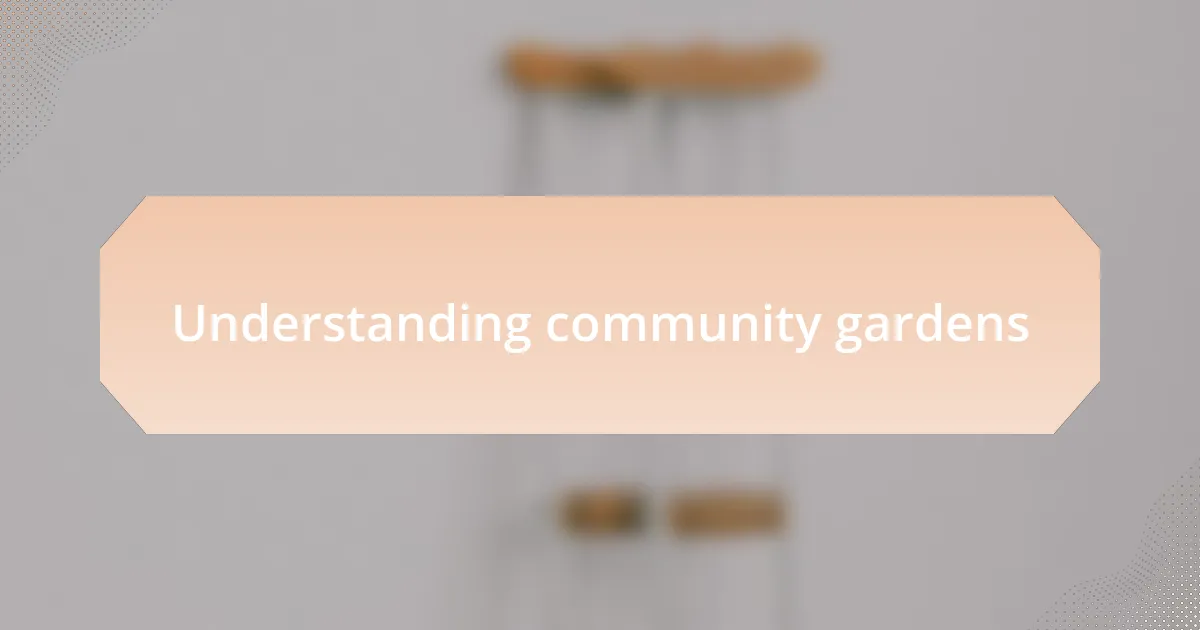
Understanding community gardens
Community gardens serve as vibrant spaces where individuals come together to cultivate not just plants but relationships. I remember walking through the colorful rows of tomatoes and sunflowers during my first visit; the laughter and camaraderie among neighbors was palpable. Have you ever experienced a place that feels like an extension of your home? That’s the essence of a community garden.
These gardens empower people to work collaboratively, sharing knowledge, resources, and, of course, a passion for gardening. I often found myself exchanging tips on pest control and organic practices with seasoned gardeners, which deepened my appreciation for both the plants and the people tending them. It’s incredible how these interactions can shift the dynamics of a neighborhood, bringing together individuals who might not have otherwise connected.
Moreover, community gardens hold a significant role in promoting sustainability and food security. I vividly recall the pride of harvesting the first vegetables of the season, knowing they were grown with love and care. Isn’t it comforting to think that we can take part in our food systems, making healthier choices right from our backyards? These gardens not only beautify spaces but also nurture a collective spirit aimed at environmental stewardship.

Benefits of community gardens
The benefits of community gardens extend far beyond just growing food; they foster a sense of belonging. I recall my initial trepidation about joining a group of strangers, but that quickly faded the moment I shared a plot with a neighbor, exchanging seeds and stories. Doesn’t it feel good to be part of something bigger than oneself?
One striking benefit is the opportunity for learning and growth. I’ve watched children marvel at how a tiny seed can lead to an abundant harvest, igniting their curiosity about nature and nutrition. It’s inspiring to think that these experiences can shape a healthier generation, right in the heart of our neighborhoods.
Additionally, community gardens promote mental well-being. I can vividly remember the calm wash over me while tending to my plants after a long day. The connection to nature and the meditative rhythm of gardening helped clear my mind. Have you ever felt that sense of peace when you’re surrounded by greenery? It’s truly remarkable how these spaces can serve as refuges, reducing stress and enhancing our overall quality of life.
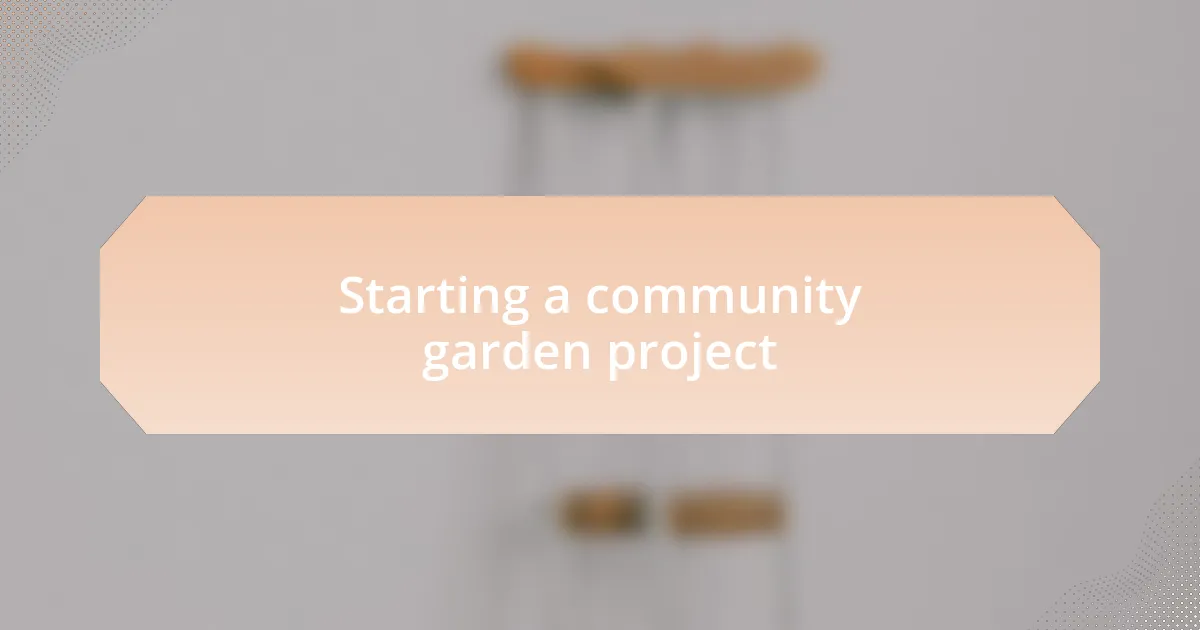
Starting a community garden project
When I decided to embark on starting a community garden project, the first step was gathering a group of like-minded individuals who shared my vision. I remember setting up a casual meeting in a local café, eager yet nervous. Isn’t it incredible how just a shared passion for growing could transform awkward introductions into a lively discussion about dreams for our garden?
Choosing the right location was another crucial aspect. We scouted various sites, finally landing on a vacant lot near our community center. I often think about how this space, once overlooked and overgrown, became a symbol of hope. Isn’t it beautiful to imagine transforming neglected areas into vibrant gardens that nourish both body and spirit?
As we began to plan, we realized that creating a garden wasn’t just about planting; it required a bit of gardening in our community itself. We organized workshops to build skills and invite everyone’s input. It struck me that these early connections fostered a sense of ownership and pride; have you ever seen a community come alive through a shared endeavor? Watching our garden grow alongside our relationships was a profound experience, highlighting how collaboration nourishes both plants and people.
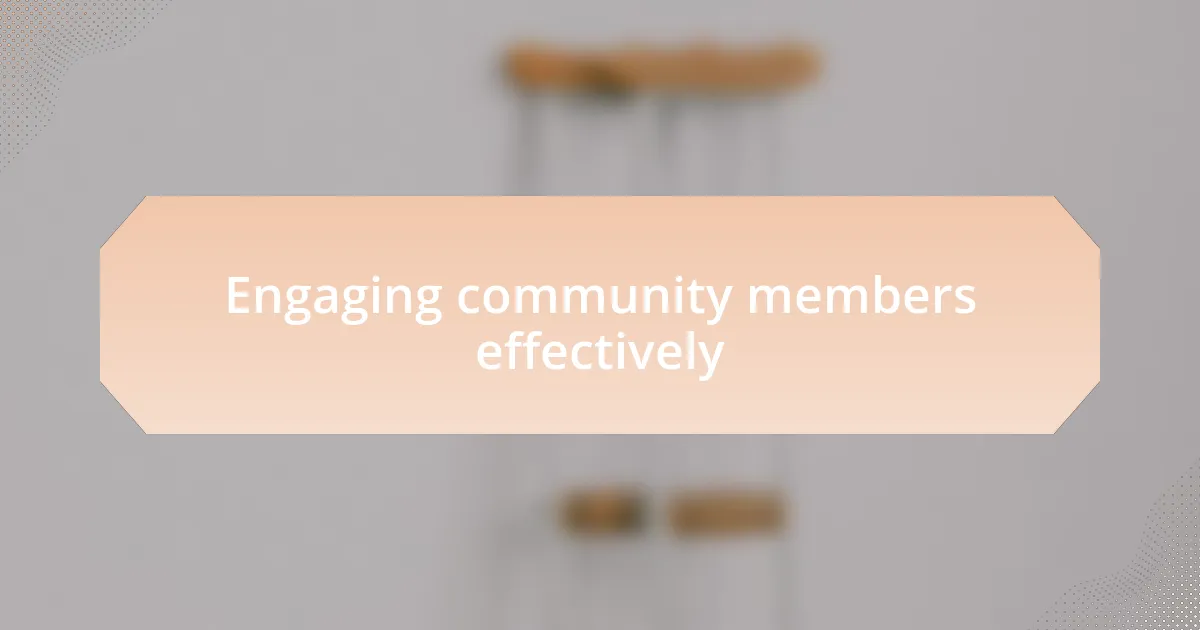
Engaging community members effectively
Engaging community members effectively involved reaching out and making sure everyone felt included. I recall hosting a potluck dinner right before we broke ground, where each person brought a dish that represented their culture. The food sparked conversations that opened our eyes to the diverse backgrounds in our community. Wasn’t it refreshing to discover how much we could learn from each other around a shared table?
Furthermore, I learned that communication was key. Regular updates via a community newsletter kept everyone in the loop and excited about our progress. I often received feedback that those updates made individuals feel more connected, as if we were all part of something bigger. How often have you felt that simple information could bridge gaps in a community?
I also made it a point to celebrate milestones with the group. When we had our first successful harvest, we hosted a small festival. I still remember the joy on everyone’s faces as they tasted the fruits of our labor. Why don’t we take the time to celebrate small victories more often? Those moments not only brought us closer together but also deepened our commitment to the garden and each other.
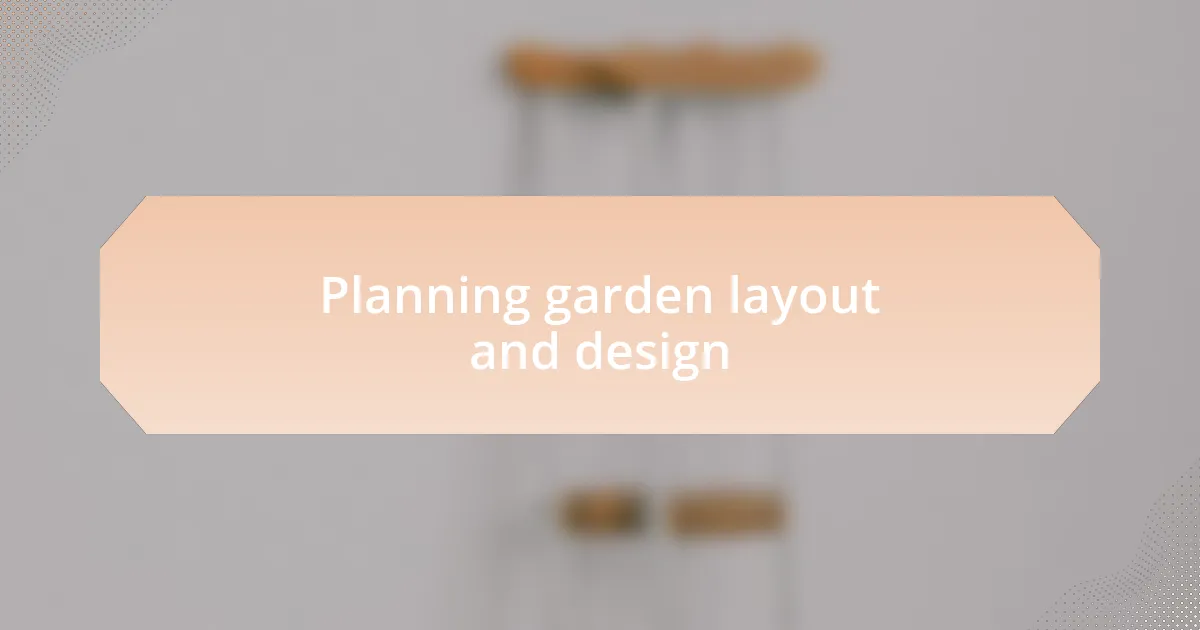
Planning garden layout and design
When it came to planning the layout and design of our community garden, I realized that every decision should reflect our collective vision. We gathered around a table with maps and markers, discussing the best spots for raised beds, pathways, and even a shared compost area. It was fascinating to see everyone’s ideas merge into a cohesive plan—who knew that a simple sketch could symbolize our shared aspirations?
I particularly remember when we debated the placement of our herb garden. Some preferred a sunny spot, while others argued for a location near the communal space, where everyone could enjoy the fragrance and have easy access. That conversation not only sparked creativity but also showcased our unique perspectives. Isn’t it incredible how a little brainstorming can transform a garden layout into a community project that embodies everyone’s input?
As we went through the final design, I felt a surge of excitement. Our plan included vibrant flower beds that would attract pollinators and benches for gathering. This design wasn’t just about growing plants; it was about cultivating relationships. How often do we invest time in creating spaces that nurture both nature and community? Each line drawn on that map was a commitment to fostering connections, both among the crops and the people who would tend to them together.
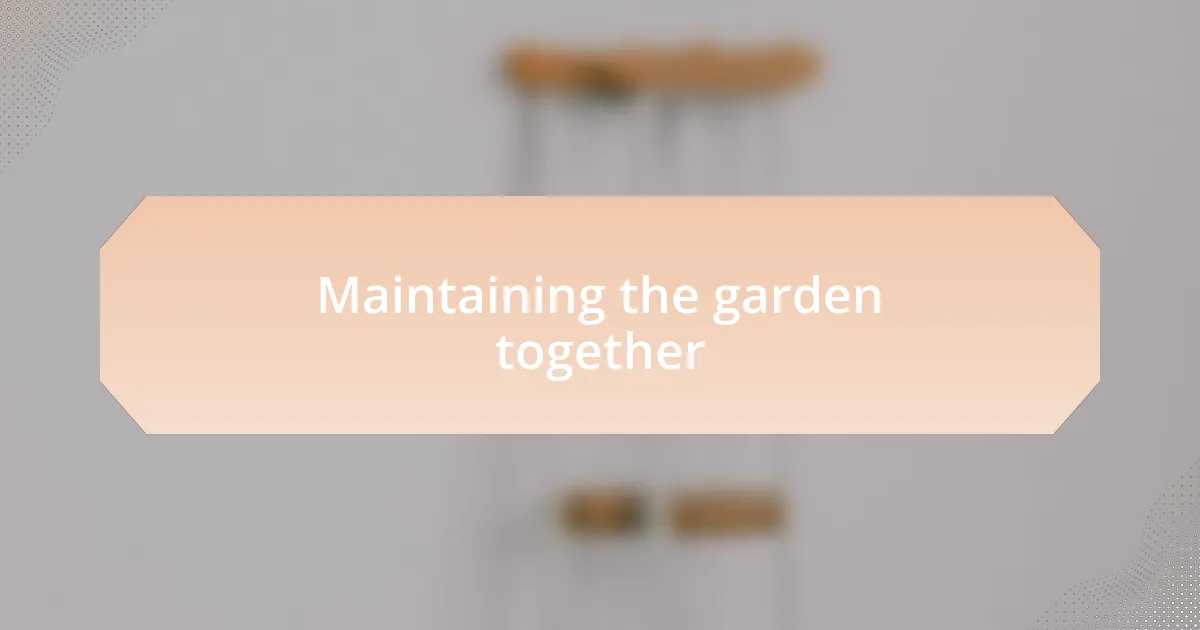
Maintaining the garden together
Working together to maintain the garden became more than just a task; it was an opportunity for bonding. I recall the first Saturday we came together to weed the flowerbeds. As we laughed and shared stories from our lives, I realized that every weed pulled was a thread weaving us closer as a community. Can something as simple as gardening really strengthen our connections?
In those moments of tending to our plants, I found joy in the shared responsibility. Each person brought their own skills, whether it was someone who understood pests or another who had a knack for pruning. I remember one volunteer teaching us how to tell the difference between good and bad bugs, transforming what could have been a frustrating task into an engaging learning experience. Isn’t it remarkable how these little lessons create not just better gardens, but also create lasting friendships?
As the seasons changed, our garden evolved and so did our group dynamics. There were days when the sun was blistering, and it felt like a challenge to stay motivated. But I vividly recall a day when one member brought homemade lemonade, lifting everyone’s spirits. It’s during these small gestures that I felt our teamwork deepen. Each time we worked together, we weren’t just maintaining the garden; we were nurturing a shared sense of purpose. Isn’t that what community is all about?
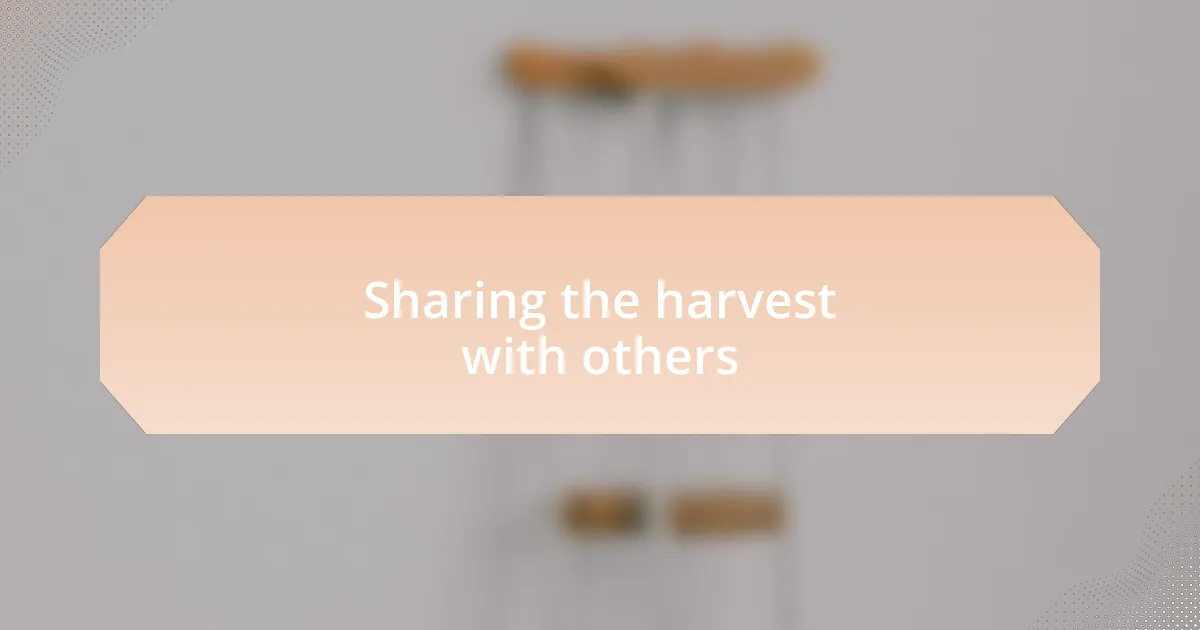
Sharing the harvest with others
Sharing the bounty from our garden was one of the most rewarding experiences I encountered. I remember the first time we gathered the produce after a successful harvest; we had an array of fresh vegetables, bursting with colors and flavors. As I filled bags to share with neighbors, I felt a sense of fulfillment that transcended just our little community. Isn’t it incredible how the fruits of our labor can feed not just our bodies, but also our relationships?
One afternoon, we decided to host a small gathering to showcase our harvest. I can still picture the smiles on everyone’s faces as we prepared dishes from the ingredients we grew together. It wasn’t merely about the food; it was a celebration of our hard work and unity. Sharing those meals created a sense of belonging that was palpable. Have you ever experienced the joy of breaking bread with others after collaborating on something meaningful?
Among the various community members who received our harvest, there were families facing tough times. Delivering baskets filled with fresh produce to their doorsteps brought tears to my eyes. I felt a deep connection, knowing that we were not only sharing food but also bringing hope and nourishment to those in need. How can we not be moved when our efforts resonate and uplift the spirits of others?